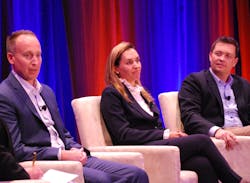Looming checkpoint for 2050 net-zero goals is within sight
The year many of the United Nation’s 2050 net-zero goals hit their preliminary 2030 targets is less than eight years away. While the panelists on the sustainability panel at Emerson Exchange all agree that the timing is ambitious, given the slower-than-hoped-for progress that’s been made, the fast-paced target dates are still needed to keep the momentum toward a sustainable future going forward.
“I don’t know if it’s achievable by 2030. There’s certainly a lot of commitments around the world to do certain things, just not enough technology for concrete plans on the ground to achieve all of that. But, if we’re going to be real about it, it’s a good idea to have a bold plan to try to get there,” said Dustin Olson, CEO of PureCycle Technologies, a startup working to change the way plastics are recycled.
With a general theme of projects, technology and culture, the session’s four panelists also included Laure Mandrou, senior vice president of the carbon-free business line, Technip Energies; Ryan Helmer, vice president of business development, Carbon America; and Mike Train, chief sustainability officer, Emerson.
Train pointed out earlier in the day during a separate session that the world needs to cut its emissions in half from current levels to reach most 2030 goals. So, the question is, can the world scale technologies and move fast enough to accomplish those goals?
Olson’s company, a part of Procter & Gamble, is doing its part to push the envelope. “Our motto is more: ‘Let’s go. Let’s believe in ourselves and our ability to solve problems. There’s no better way to test what you can do than by doing it,’” he said.
Carbon capture and sequestration (CCS) is a bourgeoning industry that captures CO2, transports it and stores in the ground, said Helmer, whose company is a CSS operator with projects in Colorado and Nebraska. It has caught the eyes of many in government and the investment community as a path forward to significantly cutting emissions from oil and gas operations. However, it is enduring a similar lack of infrastructure investment and an immature regulatory environment that has in many ways slowed its progress.
That hasn’t stopped Helmer, an 18-year oil-and-gas-industry veteran, and his colleagues from pushing forward. “Our company motto is to capture and sequester as much CO2 as possible, as quickly as possible,” he said. “The challenging thing is we’re in a new space and an unfamiliar industry. It’s unfamiliar to the landowners, stakeholders and regulators. It’s a challenge every day to educate them and move forward.”
But, he said, enthusiasm for the CCS projects is sky high. The next step is to put plans and pledges into real projects. “Once we get a few projects going, people will see that the ball is really rolling. We can do this,” Helmer added. “The United States has great geology for CO2 storage. We’ve just got to get projects up.”
To do that, he said, takes visionary leadership and “folks who are willing to take some risks and move projects forward.” He added that policy changes have put incentives for growth in the industry in place.
Train agreed that the 2030 goals are looking less likely to succeed, but he said many countries and companies are already leaning into sustainability models, as PureCycle and Carbon America already have. “I think we are going to solve our problems,” he said of the world’s efforts.
Olson agreed with Train’s optimism saying we, as a society, “need to get over the idea that it is impossible. We just need to build the momentum.”
Mandrou, representing French engineering and energy transition company Technip Energies, added a European perspective to the conversation. She said, even in countries that have moved ahead of the pack in leading the investment and regulatory charge to net zero, challenges still remain.
“There is a big journey to get there. There are some technology solutions available,” she said. “We need to make the financials work to get there. We all need to come with really strong cases to policy makers and financial investors as well as the technology makers.”
All of the panelists said no one can get there alone. Partnerships will be needed, and technology providers will need to take the lead on helping fledging companies take flight on sustainability. “A lot of project developers are new to the space,” Mandrou said. “At Technip, we help them get the project to the starting line.”
Olson recalled the early days of PureCycle Technologies. It had developed the technology to recycle plastics for use in fossil-quality materials, but he admitted that “when you’re starting a business, you really don’t know what you are doing.”
“You need a lot of help, and you need a lot of strong partners to help you,” he said. “We’ve been very fortunate to have a lot of key strategic partners that have provided technical support, guidance and platforms, such as Emerson Exchange, to getting the message out.
“If you’re thinking inside of your own box and not engaging people on the outside, you’re missing the boat,” he added. “There is so much more power in a movement when there are multiple people working together.”
Another possible partner of significance, particularly in the United States, that Train identified as noticeably absent from the panel conversation was the government. Policymakers play a significant role in advancing sustainable business. For example, Helmer pointed out the lack of permitting efficiency for CCS in many states. In some cases, it can take up to four years to gain a permit. In many states, necessary forms to apply for CCS permits do not yet exist.
There’s a lot of work yet to be done to open the roadmap to net-zero success. While curves and potholes remain in the way, it takes adventurous companies such as the three on stage at the sustainability panel to drive worldwide momentum.
Get the best of Emerson Exchange Americas 2022
When the event comes to a close, the best, most important coverage will be compiled into a report. Register now to pre-order the report and be among the first to receive it in your inbox.
About the Author

Leaders relevant to this article:


